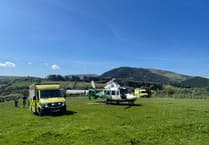Have you got 15 minutes to spare between now and August 7?
The Big Butterfly Count needs you to be part of its annual citizen science survey, now in its 13th year, in a bid to better understand the butterfly population of Great Britain.
Last year more than 100,000 people took part, and they counted more than 150,000 butterflies and day-flying moths.
Butterflies are a vital part of our ecosystem – they are prolific pollinators, and they also form an important component in the food chain.
It is all the more shocking, then, that around half of our native species have been added to the butterfly conservation ‘red list’ (meaning that they are endangered); and in recent years four species have been classified as extinct (the black-veined white, the large tortoiseshell, the large copper and the mazarine blue).
Much more needs to be done to protect our butterflies from environmental threats such as the changing use of land and loss of habitat, the use of pesticides and climate change.
We can all do our bit, from planting butterfly-friendly plants in our gardens (plants such as fuscia, lavender and buddleia), allowing parts of our gardens to ‘re-wild’ (butterflies love nettles, for example), through to helping scientists to understand population densities.
Which is why the Big Butterfly Count is so important.
Another reason to take part, and to encourage children to take part, is that the survey may spark a deeper interest in these beautiful insects, and nature in general, which could lead to more environmentally friendly behaviours.
Taking part also gives people a sense of agency in that they are doing something proactive to help wildlife – and the information generated will provide vast quantities of invaluable data.
Most scientific studies of butterflies are undertaken in open countryside, whereas the majority of Big Butterfly Count observations take place in people’s gardens or in local parks, and so they help to ‘balance’ the data.
Once it is analysed, this data will help conservationists to target their efforts more effectively, and ultimately it will help to address the decline in butterfly species identified as being at risk.
Butterflies are diurnal, which means they are only active during the day.
The best time to see them is when the sun is out, during the hottest times of the day – so usually between midday and 2pm. In fact, butterflies can’t fly when they’re cold and on cooler days they need to warm up their flight muscles either by shivering or by basking in sunlight.
The appearance of butterflies – the vibrant colours and range of patterns on their wings – is not the only fascinating thing about these magical insects.
Did you know that they taste with their feet through tiny receptors? Adults can feed only on liquids – usually nectar and rain water – and butterfly wings are transparent, and covered by thousands of tiny scales that reflect light.
As a butterfly gets older (most live for just a few short weeks) these scales fall off and the wings lose their lustre, and so this is a great way to work out whether a butterfly is young or old.
The Big Butterfly Count is for everyone, from experienced biological recorders to complete beginners who may find that taking part in the survey sparks a life-long passion.
And taking part couldn’t be simpler. Visit www.bigbutterflycount.org to find out more.
You can record your sightings in just a few minutes on this website, or download an app for your phone.
And don’t worry if you can’t tell your painted lady from your red admiral, because you can also download a free butterfly guide to help you identify the various types of butterfly that you can expect to see, in all their colourful and charismatic glory.

.png?width=209&height=140&crop=209:145,smart&quality=75)
.jpeg?width=209&height=140&crop=209:145,smart&quality=75)


Comments
This article has no comments yet. Be the first to leave a comment.